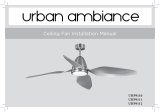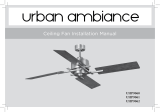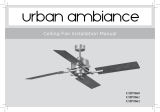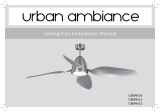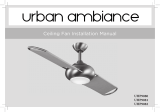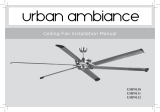Page is loading ...

Ceiling Fan Installation Manual
UHP9010
UHP9011
UHP9012

Table of Contents
Safety Rules.....................................................................................................................................................................................
Unpacking Your Fan .......................................................................................................................................................................
Installing Your Fan .........................................................................................................................................................................
Installing the Light Kit and Glass Shade ........................................................................................................................................
Operating Your Transmitter ..........................................................................................................................................................
Care of Your Fan ...........................................................................................................................................................................
Troubleshooting ............................................................................................................................................................................
Specifications ................................................................................................................................................................................
1.
2.
3.
8.
9.
10.
12.
13.

1. Safety Rules
To reduce the risk of electric shock, ensure electricity has been turned off
at the circuit breaker or fuse box before beginning.
All wiring must be in accordance with the National Electrical Code
“ANSI/NFPA 70-1999” and local electrical codes. Electrical installation
should be performed by a qualified licensed electrician.
The outlet box and support structure must be securely mounted and
capable of reliably supporting a minimum of 35 lbs (15.9 kg) or less. Use
only cUL-listed outlet boxes marked “FOR FAN SUPPORT.”
The fan must be mounted with a minimum of 7 ft. (2.1m) clearance from
the trailing edge of the blades to the floor.
Avoid placing objects in the path of the blades.
To avoid personal injury or damage to the fan and other items, be
cautious when working around or cleaning the fan.
Do not use water or detergents when cleaning the fan or fan blades. A dry
dust cloth or lightly dampened cloth will be suitable for most cleaning.
After making electrical connections, spliced conductors should be turned
upward and pushed carefully up into the outlet box. The wires should be
spread apart with the grounded conductor and the equipment-grounding
conductor on one side of the outlet box and ungrounded conductor on the
other side of the outlet box.
All set screws must be checked and retightened where necessary before
installation.
Suitable for use with solid-state speed control.
1.
2.
3.
4.
5.
6.
7.
8.
9.
10.
NOTE
READ AND SAVE THESE INSTRUCTIONS
WARNING
TO REDUCE THE RISK OF PERSONALL INJURY, DO NOT BEND THE
BLADE ARMS (ALSO REFERRED TO AS FLANGES), WHEN
INSTALLING THE BRACKETS, BALANCING THE BLADES OR
CLEANING THE FAN. DO NOT INSERT FOREIGN OBJECTS IN –
BETWEEN ROTATING FAN BLADES.
WARNING
TO REDUCE THE RISK OF FIRE, ELECTRIC SHOCK, OR OTHER PERSONAL
INJURY, MOUNT FAN ONLY ON AN OUTLET BOX OR SUPPORTING
SYSTEM MARKED ACCEPTABLE FOR FAN SUPPORT OF 35 LBS (15.9 KG)
OR LESS AND USE MOUNTING SCREWS PROVIDED WITH THE OUTLET
BOX. MOST OUTLET BOXES COMMONLY USED FOR THE SUPPORT OF
LIGHTING FIXTURES ARE NOT ACCEPTABLE FOR FAN SUPPORT AND
MAY NEED TO BE REPLACED. CONSULT A QUALIFIED ELECTRICIAN IF IN
DOUBT.

Unpack your fan and check the contents. You should have the following items:
Unpacking Your Fan 2.
13. Loose parts bag containing:
a. Blade holders attachment hardware
1/4"x22mm screws with lock washers (9)
b. Blade attachment hardware
1/4"x1/2" screws with lock washers (9)
c. Mounting hardware
Wire nuts (3)
1. Fan blades (4)
2. Canopy assembly
3. Ball/downrod assembly
4. Coupling cover
5. Fan motor assembly
6. Set of blade holders (4)
7. Mounting plate
8. 24 Watt LED light kit
9. Glass shade
10. Transmitter incl. holder + 2 mounting screws
11. 12V battery
12. Balancing kit
1
8
10
9
5
6
7
13
ab
11
12
c
4
3
2

Tools Required
Phillips screw driver, straight slot screw driver,
adjustable wrench, step ladder, and wire cutters.
Mounting Options
If there isn't an existing cUL listed mounting
box, then read the following instructions.
Disconnect the power by removing fuses or
turning off circuit breakers.
Secure the outlet box directly to the building
structure. Use appropriate fasteners and building
materials. The outlet box and its support must be
able to fully support the moving weight of the
fan (at least 35 lbs). Do not use plastic outlet
boxes.
Figure 4
Figure 3
Figure 1
Figure 2
Outlet box
Outlet box Outlet box
Note: You may need a longer downrod to
maintain proper blade clearance when installing
on a steep, sloped ceiling.
To hang your fan where there is an existing
fixture but no ceiling joist, you may need an
installation hanger bar as shown in Figure
4.
3. Installing Your Fan
WARNING
TO REDUCE THE RISK OF FIRE, ELECTRIC
SHOCK, OR OTHER PERSONAL INJURY,
MOUNT FAN ONLY TO AN OUTLET BOX
MARKED ACCEPTABLE FOR FAN SUPPORT
AND USE THE MOUNTING SCREWS
PROVIDED WITH THE OUTLET BOX. OUTLET
BOXES COMMONLY USED FOR THE
SUPPORT OF LIGHTING FIXTURES MAY NOT
BE ACCEPTABLE FOR FAN SUPPORT AND
MAY NEED TO BE REPLACED. CONSULT A
QUALIFIED ELECTRICIAN IF IN DOUBT.
Angled ceiling
maximum
24 angle
Recessed
outlet box
Provide strong support
Ceiling
hanger
bracket

4.
Hanging the Fan
REMEMBER to turn off the power. Follow
the steps below to hang your fan properly:
Step 1. Remove the decorative canopy bottom
cover from the canopy by turning the cover
counter clockwise.(Fig. 5)
Step 2. Remove the mounting bracket from
the canopy by removing the 1 of 2 screws
from the bottom of the mounting bracket and
loosening the other one a half turn from the
screw head. Next, turn the canopy counter
clockwise to removing the mounting bracket
from the canopy. (Fig. 5)
Step 3. Pass the 120-volt supply wires
through the center hole in the ceiling hanger
bracket as shown in Fig. 6.
Step 4. Secure the hanger bracket to the
ceiling outlet box with the screws and
washers provided with your outlet box.
Step 5. Remove the hanger pin, lock pin and
set screws from the top of the motor
assembly. (Fig. 7)
Step 6. Route the safety cable and wires
exiting from the top of the fan motor through
the coupling cover, canopy cover and canopy
and then through the ball / downrod. (Fig. 7)
Step 7. Align the holes at the bottom of the
downrod with the holes in the collar on top of
the motor housing (Fig. 7). Carefully insert
the hanger pin through the holes in the collar and
downrod. Be careful not to jam the pin against the
wiring inside the downrod. Insert the locking pin
through the hole near the end of the hanger pin until it
snaps into its locked position, as noted in the circle
inset of Fig. 7.
WARNING
FAILURE TO PROPERLY INSTALL
LOCKING PIN AS NOTED IN STEP 7
COULD RESULT IN FAN LOOSENING AND
POSSIBLY FALLING.
Figure 6
Figure 7
Ceiling
hanger
bracket
Mounting screws
(supplied with
electrical box)
cUL Listed
electrical
box
120V Wires
Washers
Supply wires
Downrod
Hanger pin Lock pin
Set screws
Canopy
Canopy cover
Coupling cover
Pin in locked
position
Step 8. Tighten two set screws on top of the fan
motor firmly. (Fig. 7)
Step 9. Place the downrod ball into the hanger
bracket socket. (Fig. 8)
Step 10. Secure the safety cable to the building
structure with a wood screw. (wood screw not
supplied) (Fig. 8)
Figure 5
Ceiling hanger
bracket
Ceiling
canopy
Canopy
cover
Safety cable

5.
Make the Electrical
Connections
WARNING: To avoid possible electrical shock,
be sure electricity is turned off at the main fuse
box before wiring.
Step 1. Motor to House Supply Wires Electrical
Connections: Connect the WHITE wire
(Neutral) from the outlet box to the WHITE wire
marked "AC in N" from the motor. (Fig. 9)
Step 2. Connect the BLACK wire (Hot) from
the outlet box to the BLACK wire marked "AC
in L" from the motor. (Fig. 9)
Secure all wire connections with the plastic wire
nuts provided.
Figure 9
Outlet Box
Black ("AC IN L")
White ("AC IN N")
White (Neutral)
Black (Hot)
Green or bare
copper (ground)
Ground (green)
(Connect to
ground wire on
hanger bracket if
no house ground
wire exists.)
Figure 8
Hanger
bracket
Canopy
Safety cable

6.
Finishing the Installation
Step 1. Tuck connections neatly into ceiling
outlet box.
Step 2. Slide the canopy up to mounting bracket
and place the key hole on the canopy over the
screw on the mounting bracket, turn canopy until
it locks in place at the narrow section of the key
holes. (Fig. 10)
Step 3. Align the circular hole on canopy with the
remaining hole on the mounting bracket, secure
by tightening the two set screws. Note: Adjust the
canopy screws as necessary until the canopy and
canopy cover are snug.
Attaching the Blade Holders
Step 1. Insert the blade holder through the slot in
the housing. Align the holes in the blade and the
fan motor assembly and secure with the blade
holder attachment screws (1/4"x22mm) with lock
washers. (Fig. 11)
Step 2. Repeat this procedure with the remaining
blade holders.
WARNING
Make sure the notch on the hanging bracket
properly sits in the groove in the hanger ball
before attaching the canopy to the bracket by
turning the housing until it drops into place.
Figure 10
Outlet box
Hanger
bracket
Canopy
Canopy cover
Screws
Figure 11
Screws (1/4"x22mm)
with lock washers
Blade holders

7.
Blade Balancing
All blades are grouped by weight. The fan may
wobble even though the blades are weighed
equally.
The following procedure should correct most
fan wobbling problems. Check after each step.
1. Check that all blade and blade arm screws are
secure.
2. Most fan wobbling problems are caused
when blade levels are unequal. Check this
level by selecting a point on the ceiling
above the tip of one of the blades. Measure
this distance as shown in Figure 13. Rotate
the fan until the next blade is positioned for
measurement. Repeat for each blade. The
distance deviation should be equal within
1/8".
3. Use the enclosed Blade Balancing Kit if the
blade wobble is still noticeable.
4. If the blade wobble is still noticeable,
interchanging two adjacent (side by side)
blades can redistribute the weight and
possibly result in smoother operation.
Touching
ceiling
Figure 13
WARNING
TO REDUCE THE RISK OF PERSONAL
INJURY, DO NOT BEND THE BLADE
HOLDERS WHILE INSTALLING,
BALANCING THE BLADES, OR CLEANING
THE FAN. DO NOT INSERT FOREIGN
OBJECTS BETWEEN ROTATING FAN
BLADES.
Attaching the Fan Blades
Step 1. Insert the blade through the hole in the
blade holder and housing. Align the holes in the
blade, blade holder through and the fan motor
assembly and secure with the blade attachment
screws (1/4"x1/2") with lock washers. (Fig. 12)
Step 2. Repeat this procedure with the remaining
blades.
Figure 12
Screws (1/4"x1/2")
with lock washers
Blades
Blade holders

Installing the
Light Kit and Glass Shade
8.
Figure 15
LED light kit
Glass shade
Screws
Mounting
plate
Figure 14
Mounting
plate
Screws
Mounting ring
Wire connectors
CAUTION: Before starting installation,
disconnect the power by turning off the circuit
breaker or removing the fuse at fuse box.
Turning power off using the fan switch is not
sufficient to prevent electric shock.
Step 1. Remove 1 of 3 screws from the posts of
the mounting ring and keep it for future use.
Loosen the other 2 screws. (Do not remove)
Step 2. Place the key holes in the mounting plate
over the two screws previously loosened from
the mounting ring. Turn the mounting plate until
the decorative cover locks in place at the narrow
section of the key holes. (Fig. 14)
Step 3. Securely tighten the two mounting
screws previously loosened and the one
previously removed.
Step 4. While holding the LED light kit under
the fan motor assembly, make the 2-pin wire
connections: (Fig. 15)
- White to white - Black to black
Step 5. Remove 1 of 3 screws from the posts of
the mounting plate and keep it for future use.
Loosen the other 2 screws. (Do not remove)
Step 6. Place the key holes in the LED light kit
over the two mounting screws previously
loosened from the mounting plate). Turn the
LED light kit until the light kit locks in place at
the narrow section of the key holes. Secure by
tightening the two light kit mounting screws
previously loosened and the one previously
removed. (Fig. 15)
Step 7. Raise glass shade up against the light kit
and secure it to fan by turning glass clockwise
until snug. DO NOT OVERTIGHTEN.

9. Operating Your Transmitter
Installing the battery
Install a 12V battery (included) into the remote
control. To prevent damage to the remote control,
remove the battery if not used for long periods. (Fig.
16)
Figure 16
ON ECE
1234
a) Select desired frequency from the transmitter.
The
dip switches can be set to 16 different combinations.
(Fig. 18)
b) From the back of the transmitter,
with the
fan’s power off, restore power to the fan. Press
and hold “SET” button for about 5 seconds and
release. If optional light kit is installed, the
light kit will flash twice and the signal light on
the hand held transmitter will come on when
the button is pressed. The fan has completed
the pairing process with the remote control and
is ready for use. (Fig. 18)
NOTE: If the self calibration test failed, turn
the AC power off; restore power and process
the self calibration test again.
NOTE: During self calibration test, the remote
is non-fuctional.
NOTE: The learning frequency function and
self calibration test will continue to retain the
last set frequency and calibration set even
when the AC power is shut off. If the
frequency is changed the self calibration test
will occur again.
Over 80W protection: When the receiver
detects motor power consumption which is
greater than 80W, the receiver power will be
stopped and operation will immediately
discontinue. Wait for 5 seconds and then turn
the receiver power back on.
Remote Control Button Definitions:
(Fig. 17)
These six buttons are used to set the fan speed as
follows:
I = minimum speed
II = low speed
III = medium low speed
IV = medium speed
V = medium high speed
VI = high speed
button: Turns the fan off.
button: Controls fan direction.
button: Controls light. Switch the “D” and “ON” dip
switch on the back of transmitter to decide the light in
“ON/OFF” or “Dimmable” condition.
(Fig. 18)
Your DC brushless motor is equipped with an
automatically learned type remote control. There are
no frequency switches on the receiver; the receiver
unit will automatically scan the frequency from the
remote control if any changes are made. The
frequency settings on the transmitter should be
changed ONLY in case of interference or if a
second or more ceiling fans with the same type of
control system are installed in the same structure.
Setting the Remote Control
Follow the below steps to set the remote control:
The auto learning function will only mandate within
60 seconds when turning the fan’s AC power ON.

Figure 18
Figure 17
ON ECE
1234
ON ECE
1234
Speed settings for warm or cool weather depend on
factors such as the room size. Ceiling height,
number of fans and so on.
NOTE: To operate the reverse function on this fan,
press the reverse button while the fan is running.
Warm weather - (Forward) A downward airflow
creates a cooling effect as shown in Fig. 19. This
allows you to set your air conditioner on a warmer
setting without affecting your comfort.
Cool weather - (Reverse) An upward airflow moves
warm air off the ceiling area as shown in Fig. 20.
This allows you to set your heating unit on a cooler
setting without affecting your comfort.
Figure 19
Figure 20
10.

Step 1. Remove the remote control holder cover
from the remote control holder.
Step 2. Attach the remote control holder with the
two remote control holder mounting screw
provided. (Fig. 21)
Step 3. Replace the remote control holder cover
into remote control holder.
Remote
Control
Holder
Remote Control
Holder Cover
Screws
Installing the Remote Control
Holder
Figure 21
Here are some suggestions to help you maintain
your fan
1. Because of the fan's natural movement, some
connections may become loose.
Check the
support connections, brackets, and blade
attachments twice a year.
Make sure they are
secure.
(It is not necessary to remove fan from
ceiling.)
2. Clean your fan periodically to help maintain
its new appearance over the years. Use only a
soft brush or lint-free cloth to avoid scratching
the finish. The plating is sealed with a lacquer to
minimize discoloration or tarnishing. Do not use
water when cleaning. This could damage the
motor, or possibly cause an electrical shock.
3.
There is no need to oil your fan.
The motor
has permanently lubricated bearings.
IMPORTANT
MAKE SURE THE POWER IS OFF AT THE
ELECTRICAL PANEL BOX BEFORE YOU
ATTEMPT ANY REPAIRS. REFER TO THE
SECTION "MAKING ELECTRICAL
CONNECTIONS".
11. Care of Your Fan

Troubleshooting
12.
Solution
1. Check circuit fuses or breakers.
2. Check line wire connections to the fan and switch wire connections in the switch housing.
CAUTION: Make sure main power is off.
1. Make sure all motor housing screws are snug.
2. Make sure the screws that attach the fan blade bracket to the motor hub is tight.
3. Make sure wire nut connections are not rubbing against each other or the interior wall of the switch housing.
CAUTION: Make sure main power is off.
4. Allow a 24-hour "breaking-in" period. Most noise associated with a new fan disappear during this time.
5. If using an optional light kit, make sure the screws securing the glassware are tight. Check that light bulb is also secure.
6. Some fan motors are sensitive to signals from solid-state variable speed controls. If you have installed this type of control,
choose and install another type of control.
7. Make sure the upper canopy is a short distance from the ceiling. It should not touch the ceiling.
1. Turn the AC power off to fan, and re-do steps for programming on page 9.
2. Do not turn off fan from standard wall switch. Use only our wall switch or your remote to regulate fan.
Problem
Fan will not start.
Fan sounds noisy.
Fan has lost its
programming
repeatedly.

13.
Specifications
This device complies with part 15 of the FCC Rules. Operation is subject to the following two conditions: (1) This device may not cause harmful interference,
and (2) this device must accept any interference received, including interference that may cause undesired operation.
Warning: Changes or modifications to this unit not expressly approved by the party responsible for compliance could void the user's authority to operate the
equipment.
NOTE: This equipment has been tested and found to comply with the limits for a Class B digital device, pursuant to Part 15 of the FCC Rules. These limits
are designed to provide reasonable protection against harmful interference in a residential installation. This equipment generates, uses and can radiate radio
frequency energy and, if not installed and used in accordance with the instructions, may cause harmful interference to radio communications.
However, there is no guarantee that interference will not occur in a particular installation. If this equipment does cause harmful interference to radio or
television reception, which can be determined by turning the equipment off and on, the user is encouraged to try to correct the interference by one or more of
the following measures:
- Reorient or relocate the receiving antenna.
- Increase the separation between the equipment and receiver.
- Connect the equipment into an outlet on a circuit different from
that to which the receiver is connected.
- Consult the dealer or an experienced radio/TV technician for help.
18.74
lbs
21.23
lbs
2.96'
Fan Size
Speed Volts
Amps Watts RPM CFM N.W. G.W. C.F.
56"
Low
High
120
120
These are approximate measures. They do not include Amps and Wattage used by the light kit.
0.051
0.46
2.34
34.64
48
156
1841.29
6112.61
/
